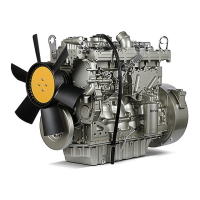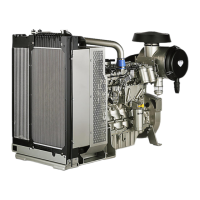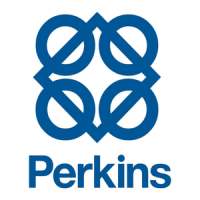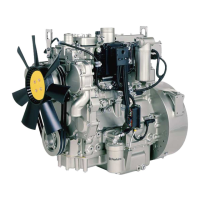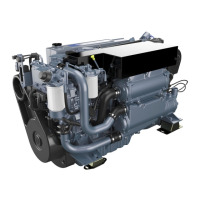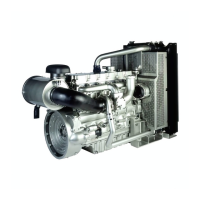Do you have a question about the Perkins 1106D and is the answer not in the manual?
Warning regarding chemicals in diesel exhaust and ethylene glycol exposure.
Information on the content, storage, and use of the manual.
Identifies and explains various warning signs on the engine.
Provides general safety precautions and hazard awareness.
Details hazards related to hot surfaces and fluids.
Covers precautions to prevent fires and explosions.
Safety guidelines for avoiding crushing and cutting hazards.
Safe procedures for mounting and dismounting the engine.
Safety warnings and inspection of high-pressure fuel lines.
Pre-start checks and procedures to ensure safe operation.
Instructions for safely starting the engine.
Procedures for safely stopping the engine.
Safety precautions related to the engine's electrical system.
Safety warnings regarding the engine's electronic control system.
General information about the engine and its components.
Proper procedures to avoid damage when welding.
Illustrations showing key engine components.
Details on the 1106 Electronic Engine model PJ.
Overview of the engine's diagnostic system.
Description of engine cooling and lubrication systems.
Information on locating and identifying engine serial numbers.
Details on emissions labels for compliant engines.
Procedures for safely lifting and storing the engine.
Guidelines for proper engine storage to prevent damage.
Explanation of engine gauges and indicator lamps.
Overview of engine features and controls.
Description of the engine's monitoring system.
Locations and functions of engine sensors.
Information on sensor malfunctions and their effects.
Details on engine shutoff conditions and alarms.
Details on engine overspeed detection and response.
Procedures for retrieving and understanding diagnostic codes.
Engine's capability to perform self-diagnostic tests.
How to retrieve diagnostic flash codes.
System capability for logging diagnostic fault codes.
Effects of active diagnostic codes on engine operation.
Handling and logging of intermittent diagnostic codes.
Detailed procedures for starting the engine.
Essential checks before starting the engine.
Step-by-step guide for starting the engine.
Checks and observations after the engine starts.
Guidelines for optimal engine operation.
Tips for efficient fuel usage.
Procedures for stopping the engine correctly.
General guidelines for normal engine shutdown.
Instructions for emergency engine shutdown procedures.
Checks and actions to perform after stopping the engine.
Guidelines for operating the engine in cold weather.
Practical advice for cold weather engine operation.
Importance of engine oil viscosity in cold weather.
Proper warm-up procedures for the engine.
Information on using engine block heaters.
Recommendations for engine idling.
How fuel properties affect cold weather performance.
Components important for cold weather fuel system operation.
Maintenance of fuel tanks for cold weather.
Importance of fuel filters in cold weather operation.
Information on fuel heaters for cold weather.
Capacities for engine oil and cooling system.
Refill capacities for the engine crankcase and oil filters.
Capacity information for external cooling systems.
Recommendations for lubricants and fluids.
Guidelines for lubricant selection and certification.
Commercial oil specifications and recommendations.
Impact of fuel sulfur on TBN and oil change intervals.
Selecting oil viscosity based on ambient temperature.
Performance characteristics of synthetic base oils.
Acceptability and use of re-refined base stock oils.
Recommended lubricants for cold weather operation.
Perkins recommendation regarding aftermarket oil additives.
Using oil analysis for preventive maintenance.
General information and disclaimers for fluid recommendations.
Requirements for satisfactory engine performance.
Characteristics of diesel fuel including cetane and viscosity.
Schedule of maintenance tasks based on service hours.
Maintenance tasks related to commissioning.
Procedure for cleaning and testing the aftercooler core.
Inspection of the aftercooler for damage and debris.
Inspection of the alternator for loose connections and charging.
Inspection of alternator and fan belts for wear.
Procedure for replacing alternator and fan belts.
Safety precautions and procedure for replacing batteries.
Procedure to check and maintain battery electrolyte levels.
Safe procedures for disconnecting battery cables.
Inspection of the belt tensioner for damage and proper installation.
Procedure for changing commercial heavy-duty coolant.
Procedure for changing Extended Life Coolant (ELC).
How to check the engine coolant level.
Testing and adding Supplemental Coolant Additive (SCA).
Procedure for replacing the crankcase breather canister.
Maintenance recommendations for driven equipment.
Procedure for cleaning the engine.
Cleaning and replacing dual element air cleaners.
Methods for cleaning primary air cleaner elements.
Inspecting and replacing single element air cleaners.
How to inspect and test the air cleaner service indicator.
Checking and cleaning the engine air precleaner.
Inspection of engine mounts for deterioration and torque.
Procedure for checking the engine oil level.
How to obtain and analyze engine oil samples.
Procedure for changing engine oil and oil filter.
Specific procedure for CG-4 oil change.
Maintenance for engine valve lash adjustment.
Checking fan clearance to the cooling system cover.
Procedures for priming the fuel system.
Using the hand pump to prime the fuel system.
Using the electric pump to prime the fuel system.
Draining the primary fuel filter/water separator.
Replacing the primary filter/water separator element.
Replacing the secondary fuel system filter.
Draining water and sediment from fuel tanks.
Procedure for cleaning the radiator.
Identifying and addressing severe service conditions.
Inspection of the starting motor for proper operation.
Visual inspection of the turbocharger.
Pre-start walk-around inspection checklist.
Inspect the crankcase breather tube for damage or obstructions.
Checking engine for leaks and loose connections.
Inspection of high-pressure fuel lines for leaks and damage.
Inspection of the water pump for leaks and damage.
General warranty information for the engine.
Information on emissions warranty coverage.
Fields to record engine and product identification details.
Fields to record dealer contact and service information.
Warning regarding chemicals in diesel exhaust and ethylene glycol exposure.
Information on the content, storage, and use of the manual.
Identifies and explains various warning signs on the engine.
Provides general safety precautions and hazard awareness.
Details hazards related to hot surfaces and fluids.
Covers precautions to prevent fires and explosions.
Safety guidelines for avoiding crushing and cutting hazards.
Safe procedures for mounting and dismounting the engine.
Safety warnings and inspection of high-pressure fuel lines.
Pre-start checks and procedures to ensure safe operation.
Instructions for safely starting the engine.
Procedures for safely stopping the engine.
Safety precautions related to the engine's electrical system.
Safety warnings regarding the engine's electronic control system.
General information about the engine and its components.
Proper procedures to avoid damage when welding.
Illustrations showing key engine components.
Details on the 1106 Electronic Engine model PJ.
Overview of the engine's diagnostic system.
Description of engine cooling and lubrication systems.
Information on locating and identifying engine serial numbers.
Details on emissions labels for compliant engines.
Procedures for safely lifting and storing the engine.
Guidelines for proper engine storage to prevent damage.
Explanation of engine gauges and indicator lamps.
Overview of engine features and controls.
Description of the engine's monitoring system.
Locations and functions of engine sensors.
Information on sensor malfunctions and their effects.
Details on engine shutoff conditions and alarms.
Details on engine overspeed detection and response.
Procedures for retrieving and understanding diagnostic codes.
Engine's capability to perform self-diagnostic tests.
How to retrieve diagnostic flash codes.
System capability for logging diagnostic fault codes.
Effects of active diagnostic codes on engine operation.
Handling and logging of intermittent diagnostic codes.
Detailed procedures for starting the engine.
Essential checks before starting the engine.
Step-by-step guide for starting the engine.
Checks and observations after the engine starts.
Guidelines for optimal engine operation.
Tips for efficient fuel usage.
Procedures for stopping the engine correctly.
General guidelines for normal engine shutdown.
Instructions for emergency engine shutdown procedures.
Checks and actions to perform after stopping the engine.
Guidelines for operating the engine in cold weather.
Practical advice for cold weather engine operation.
Importance of engine oil viscosity in cold weather.
Proper warm-up procedures for the engine.
Information on using engine block heaters.
Recommendations for engine idling.
How fuel properties affect cold weather performance.
Components important for cold weather fuel system operation.
Maintenance of fuel tanks for cold weather.
Importance of fuel filters in cold weather operation.
Information on fuel heaters for cold weather.
Capacities for engine oil and cooling system.
Refill capacities for the engine crankcase and oil filters.
Capacity information for external cooling systems.
Recommendations for lubricants and fluids.
Guidelines for lubricant selection and certification.
Commercial oil specifications and recommendations.
Impact of fuel sulfur on TBN and oil change intervals.
Selecting oil viscosity based on ambient temperature.
Performance characteristics of synthetic base oils.
Acceptability and use of re-refined base stock oils.
Recommended lubricants for cold weather operation.
Perkins recommendation regarding aftermarket oil additives.
Using oil analysis for preventive maintenance.
General information and disclaimers for fluid recommendations.
Requirements for satisfactory engine performance.
Characteristics of diesel fuel including cetane and viscosity.
Schedule of maintenance tasks based on service hours.
Maintenance tasks related to commissioning.
Procedure for cleaning and testing the aftercooler core.
Inspection of the aftercooler for damage and debris.
Inspection of the alternator for loose connections and charging.
Inspection of alternator and fan belts for wear.
Procedure for replacing alternator and fan belts.
Safety precautions and procedure for replacing batteries.
Procedure to check and maintain battery electrolyte levels.
Safe procedures for disconnecting battery cables.
Inspection of the belt tensioner for damage and proper installation.
Procedure for changing commercial heavy-duty coolant.
Procedure for changing Extended Life Coolant (ELC).
How to check the engine coolant level.
Testing and adding Supplemental Coolant Additive (SCA).
Procedure for replacing the crankcase breather canister.
Maintenance recommendations for driven equipment.
Procedure for cleaning the engine.
Cleaning and replacing dual element air cleaners.
Methods for cleaning primary air cleaner elements.
Inspecting and replacing single element air cleaners.
How to inspect and test the air cleaner service indicator.
Checking and cleaning the engine air precleaner.
Inspection of engine mounts for deterioration and torque.
Procedure for checking the engine oil level.
How to obtain and analyze engine oil samples.
Procedure for changing engine oil and oil filter.
Specific procedure for CG-4 oil change.
Maintenance for engine valve lash adjustment.
Checking fan clearance to the cooling system cover.
Procedures for priming the fuel system.
Using the hand pump to prime the fuel system.
Using the electric pump to prime the fuel system.
Draining the primary fuel filter/water separator.
Replacing the primary filter/water separator element.
Replacing the secondary fuel system filter.
Draining water and sediment from fuel tanks.
Procedure for cleaning the radiator.
Identifying and addressing severe service conditions.
Inspection of the starting motor for proper operation.
Visual inspection of the turbocharger.
Pre-start walk-around inspection checklist.
Inspect the crankcase breather tube for damage or obstructions.
Checking engine for leaks and loose connections.
Inspection of high-pressure fuel lines for leaks and damage.
Inspection of the water pump for leaks and damage.
General warranty information for the engine.
Information on emissions warranty coverage.
Fields to record engine and product identification details.
Fields to record dealer contact and service information.
